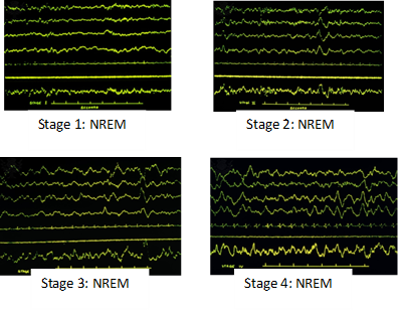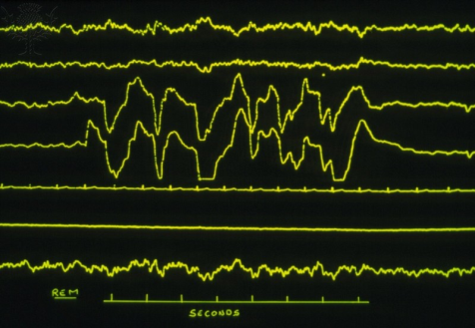The Brain
Higher Brain Functions: The EEG and Sleep
A characteristic of all excitable tissues (nervous and muscle tissue) is that they are capable of generating and propagating signals that involve changes in the electrical charge on the cell membrane. We have described these changes in earlier modules and given them the names of action potentials and local potentials. The neurons of the brain are constantly generating these electrical signals. Imagine two neurons in close proximity, one has depolarized such that on the outside of the membrane there is a negative charge and on the inside of the membrane and a positive charge. The other neuron is at rest and the outside is positive while the inside is negative. These differences in charge on the outside of the neurons create electrical fields that can be detected my sensitive electrodes strategically placed on the skin of the scalp and recorded on an instrument known as an electroencephalograph. An electroencephalogram (EEG) is the tracing recorded by this instrument. Although there is no regular, repeating pattern like might be seen in an electrocardiogram, the information from the EEG can be very useful in evaluating conditions in the brain. Indeed, a flat EEG is a sign of clinical death. Based on the frequency and amplitude of the tracings, four EEG patterns can be discerned. If we were to record your EEG right now as you are reading this material we should detect beta waves. Beta waves have a frequency of 13-30 Hertz (cycles per second) and are common when the subject is awake with their eyes open and their brains engaged. Now close your eyes and try to relax and let your mind wander. Alpha waves would be recorded under these conditions. Alpha waves have a frequency of 8-13 Hz and a higher amplitude than beta waves. These are the only two types of waves that we should see in normal, healthy adults. Theta waves (4-7 Hz) can be seen in the early stages of sleep and in young children. Finally, delta waves (.5-4 Hz) are only seen during deep sleep or in adults with serious brain injury. As the frequency decreases the amplitude of the waves gets larger. The larger amplitude is because the activity is more synchronized, probably because the cortex is not receiving stimulatory input from the reticular system. Consider the research from Harvard professor Eric Mazur in which he continually monitored brain patterns of students for one week. The data showed that brain waves were almost completely flat during two events, watching television and listening to a classroom lecture. Coupled with the Australian study of 11,000 adults that showed that for every hour of television watched 22 minutes of lifespan was lost, one begins to wonder if students will ever survive college as the two biggest time sinks are lecture and television.
Sleep
One of the mysteries of science is why we have to sleep. Several theories have been proposed as to why we sleep. Some of the more probable include: 1) When one sleeps, they are not as likely to be seen and hunted by predators. 2) It may be a way of conserving energy. 3) It may allow the body to repair itself and/or recover from intense activities. 4) Sleep may allow the brain to work through emotional events and helps to eliminate accidental, repetitions and meaningless communications that have occurred throughout the day. 5) It may give the brain the opportunity to archive and store important memories. All of these are possible benefits and reasons for sleep, however, we really don't know exactly why we have to sleep. William Dement, a pioneer in sleep research and founder of Stanford's Sleep research center summed up why we sleep as follows, "As far as I know, the only reason we need to sleep that is really, really solid is because we get tired".
Let's exam what we know about sleep. There are two different kinds of sleep: rapid eye movement (REM) sleep and non-REM (NREM) sleep. In addition, NREM sleep can be divided into four stages (stages 1-4). In young healthy adults that sleep regularly (probably those who live alone or got married young); a typical night’s sleep starts with NREM sleep, passing through all 4 stages of NREM stages and then quickly reverts to REM sleep. The stages of sleep will then alternate between REM and NREM throughout the night. The cycle to REM sleep occurs about every 90 minutes. Each time REM sleep is reached it lasts a little longer. For instance the first REM stage lasts about 5 to 10 minutes and the final REM stage can last up to an hour.
The different stages of sleep are marked by changing patterns of the EEG. During stage 1 of NREM the predominant brain waves are alpha waves. During this phase vital signs (heart rate and blood pressure) are normal and the person can be easily aroused. During stage 2 of NREM brain waves slow to 12-14 Hz and the individual becomes more difficult to arouse. In Stage 3 theta and delta waves appear and vital signs begin to change, heart rate decreases, body temperature drops and blood pressure goes down. In stage 4 delta waves are present and vital signs are at their lowest. This is the stage where sleep walking and night terrors occur. The normal progression takes about 30-45 minutes to reach this stage of deep sleep.

© 2013 Encyclopædia Britannica, Inc. Downloaded from Image Quest Britannica; BYU-Idaho.
Data obtained from multiple subjects using an EEG to demonstrate the different wave patterns of NREM sleep.
Upon reaching stage 4 sleep we quickly backtrack to alpha waves and enter the phase of REM sleep. It is during this phase that we have our most vivid dreams. Also during REM sleep skeletal muscles are paralyzed (probably so that we don't act out our dreams) except for eye movements (see figure below). Heart rate and respiration also increase and the brain uses even more oxygen than the awake state. So do we really need to sleep? Well, individuals that do not get REM sleep become moody, depressed and even exhibit various types of personality disorders. Some sleep medications increase NREM sleep but can actually decrease REM sleep worsening, the conditions already prescribed. An interesting study has suggested a link between lack of sleep and diabetes (Touma and Pannain, 2011; does lack of sleep cause diabetes?). Sleep requirements change with age, infants require 16 hours while adults need only 7-8 hours. To wake up, neurons in the reticular formation begin to release chemicals that begin to rouse the cortex. As stated earlier, caffeine stimulates the reticular formation giving a jump start to the system, or preventing the system from shutting down. As a result 68 million people in the US have a cup of coffee within one hour of waking up. The alternative is to sleep consistently so that the body develops its own natural “wake up” cycle.

© 2013 Encyclopædia Britannica, Inc. Downloaded from Image Quest Britannica; BYU-Idaho.
Data obtained from multiple subjects using an EEG to demonstrate the different wave patterns of REM sleep.
**You may use the buttons below to go to the next or previous reading in this Module**


